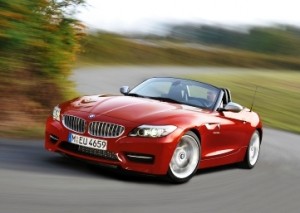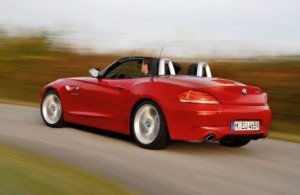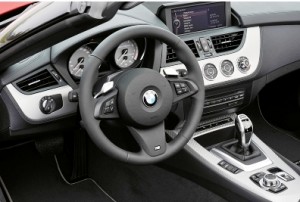It almost takes longer to pronounce the name, than it does for the new 2010 BMW Z4 sDrive35 roadster to reach 62 mph from a stop — 4.8 seconds, according to the Bavarian maker of mostly coupes, sedans and sport utility vehicles.
During the 2010 North American International Auto Show, BMW will unveil its latest iteration of a classic roadster with its inline six-cylinder engine and dual turbochargers.
Power output is rated at 250 kW/340 horsepower, and peak torque is 450 Newton-meters or 332 pound-feet. With a seven-speed Sport automatic transmission featuring double clutches – first time in the U.S. — the sports car is more than adequately quick. And, once again, BMW is at pains to point out, it comes with no increase in fuel consumption. Whether the price increase from $52,000 remains to be seen.
At 9.0 liters/100 kilometers (equal to ~26 mpg U.S.) and 210 grams CO2 per kilometer in the EU test cycle, both fuel consumption and CO2 emissions are the same as on the BMW Z4 sDrive35i with the older six speed Sport Automatic.
Environmental pressure groups, such as the Union of Concerned Scientists, have been hammering BMW (and other companies) for what they deem are excessive increases in power-to-weight ratios while only pursuing token fuel economy and carbon dioxide reduction measures.

BMW cloaks its longstanding performance marketing in a relatively new semi-green moniker of "Efficient Dynamics."
They have a point, of course, but one that ignores long standing automotive marketing tenets, which the industry shows no signs of abandoning.
BMW cloaks its longstanding performance marketing in a relatively new semi-green moniker of “Efficient Dynamics,” with its new products bearing significant increases in power, performance and driving dynamics at about the same fuel economy.
It cannot go on forever of course, as regulations will eventually force weight and powertrain size reductions at all makers, and a new game of automotive chicken will emerge as companies try to balance fuel efficiency against sheer power. As a case in point, the 2010 BMW Z4 sDrive35 emits about twice as much CO2 as new European and proposed U.S. regulations require. What would a higher performance M version emit?
How this sorts, itself out in the marketplace will be the subject of much debate and billion upon billions of engineering development and tooling dollars during decade two of the 21st century. And the reason why you will see more small 1-Series Bimmers in the U.S., including electric versions and or hybrid versions.



Obviously BMW is catering to clientel who like cheap thrills and are willing to throw lots of money away to achieve them.
The sort of customer attracted to this car is not concerned with environmental issues or where mankind is headed just kicks for the moment.
I am always bemused by people who get their kicks from quick acceleration and high speed cornering and are willing to waste their money achieving it. I would say to everyone of them go hop into the second seat of an F15 or straddle one of the big bikes and see how that puts things into perspective. There is always something faster and more exciting, hell go jump off a cliff.